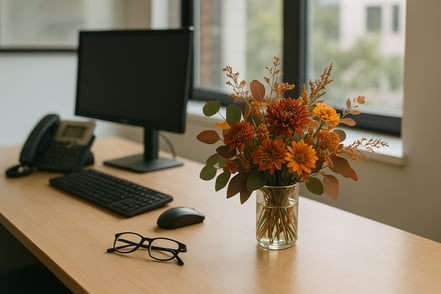The demand for plantscaping—using living plants to enhance interior spaces—continues to grow. Once limited to corporate lobbies and hotel atriums, indoor greenery has become a must-have in homes, offices, retail spaces, and restaurants. Today’s residential and corporate clients are looking for ways to bring nature indoors in a way that feels intentional, natural, stylish, welcoming and calming.
For florists, this trend offers new opportunities to expand product offerings and generate consistent revenue. Whether you’re already selling plants or just starting to explore this market, understanding key trends in interior plantscaping can help you grow your business and connect with modern plant lovers.
The Rise of Biophilic Design
At the heart of today’s plantscaping movement is biophilic design—a concept that emphasizes humans’ innate connection to nature. It’s not just about decorating with plants; it’s about creating environments that support well-being, productivity, and emotional balance.
Biophilic design goes beyond placing a potted fern in the corner. It incorporates living elements into architecture, layout, and aesthetics. Think living walls, hanging plant installations, or integrated planter dividers in open-concept offices. Even residential customers are embracing this approach by transforming home offices and kitchens into lush, plant-filled sanctuaries.
For florists, this trend opens the door to larger-scale installations, subscription services for plant maintenance, and curated plant collections that meet both design and wellness goals.
Statement Plants Take the Spotlight
While small succulents and basic foliage remain popular, statement plants are leading the way in modern plantscaping. Customers want big, bold greenery that fills space and makes an instant impact.
Top picks include:
- Fiddle Leaf Fig: With its large, glossy leaves and sculptural form, this plant remains a designer favorite.
- Monstera Deliciosa: Iconic split leaves make this plant a striking focal point in any room.
- Bird of Paradise: Adds a tropical, architectural feel with wide, upright leaves.
- Rubber Tree: Deep green or burgundy leaves bring drama and polish.
- Kentia and Areca Palms: Ideal for airy, upscale environments in homes or commercial spaces.
- Spathiphyllum: Known for its air-purifying properties, it brings a sense of calm and softness to interior spaces, especially in low-light rooms.
- Dracaena Warneckii: especially ‘Lemon Lime’
These plants work especially well in modern, minimalist spaces where their form and texture become part of the interior design. Offering delivery and setup for large-scale plants adds a layer of service that customers will happily pay for.
Incorporating lush greenery and elegant planters into client spaces helped us bring the outdoors in while keeping each design stylish and modern in Arlington, TX. - Richard Snyder, Divine Floral, Gifts & Flower Delivery
Creative Display Techniques
Today’s plantscaping isn’t just about what plants you offer—it’s about how you present them. Customers want curated, stylish plant displays that match their interiors.
Trending display options include:
- Wall-mounted planters for vertical interest in small spaces.
- Hanging installations using macrame, leather straps, or modular hanging systems.
- Clustered displays of plants in varying sizes and heights for a layered look.
- Mixed-material planters in concrete, ceramic, brass, and wood finishes.
As a florist, you can enhance your plant offerings by styling packages that include both plants and display elements. Think of it as interior design with a botanical twist.
Maintenance Services and Subscriptions
While many customers love the look of plants, they may not have the time—or confidence—to care for them. That’s where your expertise becomes invaluable.
Offer maintenance services for commercial clients or high-end residential customers. Services could include scheduled watering, pruning, cleaning, pest checks, and container refreshing. For smaller-scale customers, consider a subscription model with seasonal plant swaps or monthly drop-offs.
These services create consistent, recurring revenue while reinforcing your shop’s reputation as a full-service floral and plant destination. These regular services maintains your brand in the client’s mind for ordering corporate and personal floral gifts throughout the year.
Education and Inspiration
Help your customers feel empowered by offering guidance on plant care, placement, and styling. Share tips in-store and online about light requirements, watering schedules, and pet-friendly options. Create plant care cards for each product and include QR codes that link to video tutorials or maintenance checklists.
Host “Plantscaping 101” workshops or private consultations to help customers style their spaces with confidence. Position yourself as the go-to source for greenery expertise—not just plant sales.
Greenery That Grows with You
Interior plantscaping isn’t a passing fad—it’s a growing lifestyle movement rooted in wellness, sustainability, and personal expression. By offering curated plant collections, eye-catching display options, and expert care services, your shop can become a trusted partner in bringing beauty and balance to indoor spaces.
As more people turn to nature for comfort and creativity, now is the perfect time to grow your plantscaping program—and watch your business flourish.
6/26/25 11:36 AM
.png?width=89&height=50&name=Blog%20Design%20(1).png)

